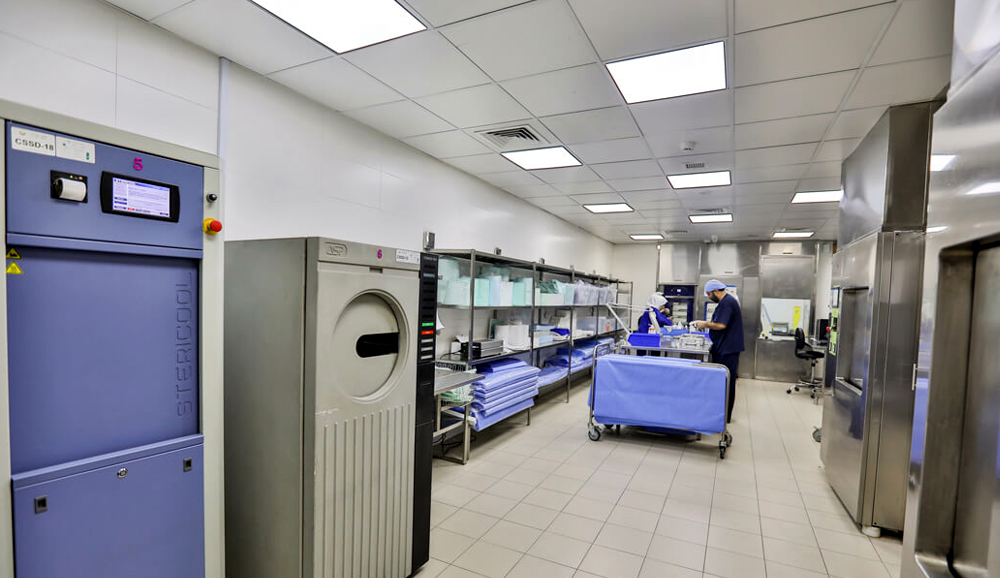Each day, millions of medical procedures are executed in healthcare facilities around the world, with caregivers and patients relying on the availability and use of a wide range of supplies, instruments and equipment. These devices must be suitably cleaned, sanitized, and/or decontaminated, examined for quality to certify decent working conditions, and obtainable at the point of maintenance. In the absenteeism of appropriate management, processing and storage, these devices may become contaminated and minimize valuable patient care.
The Central Sterile Services Department (CSSD) is an organized place in hospitals and other health care services that performs sterilization and other activities on medical devices, equipment and consumables; for ensuing use by health workers in the operating theatre of the hospital and also for other aseptic processes, e.g., catheterization, wound stitching and bandaging in a medical, surgical, maternity or paediatric ward.
Sterilization is the procedure of destroying all living organisms on an article and is the chief duty of most sterile amenities departments. Objects to be sterilized must first be cleaned in an isolated decontamination room and inspected for efficiency, hygiene and damage. There are numerous procedures of sterilization, and which one is used is reliant on countless factors including: operational cost, latent hazards to workers, effectiveness, time, and arrangement of the articles being sterilized.
The CSSD has a significant part in patient care and in minimizing hospital surgical contamination. Various hospital departments depend on the service from the CSSD. With the centralization of the pre-disinfection, cleaning, packing and disinfection of all objects in one section, it is of supreme importance to deliver dependably high quality in the sterilization methods and product quality. As the quantity and variation of medical procedures and the kinds of medical devices are regularly mounting, improved processing is imperative for competence, economy and patient care.
Sterile processing departments are usually separated into 4 major areas to achieve the roles of sanitization, assemblage and sterile processing, disinfected storage, and dispersal.
Decontamination
- Dismantlement & cleansing used surgical devices and other medical apparatus
- Working and preserving special sanitization apparatus like automatic washers/purifiers, ultrasonic cleaners, etc.
- Examining cleansed items to make sure they are hygienic
- Assemblage
- Operate PPE’s to shield self from getting harmful infections
Sterilization and Storage
- Assemblage & packaging of cleaned and disinfected apparatuses
- Disinfecting amassed trays of devices in suitable sterilizers
- Precisely working and managing special sterilization equipment like autoclaves
- Maintaining thorough records of figures of sterilized items, including Autoclave cycle statistics, lot/batch figures, expiration dates for forthcoming tracking of objects that have been sterilized, and stockpiled
Distribution
- Providing crash carts
- Maintaining decontaminated medical provisions
- Confirming that disinfected goods do not become obsolete/averting incident linked sterility problems
- Transporting sterile provisions where they are required and collecting contaminated ones

In most healthcare facilities, the central sterile supply department (CSSD) plays a crucial part in provisioning the items essential to provide quality patient care. To back infection control within the healthcare system, the CSSD staff members must be sufficiently trained and capable, and dedicated to doing the right thing. That means guaranteeing that shortcuts are never taken and that procedures and practices are dependably followed.
Applying advanced technologies and procedures may aid in increasing security for patients and staff. High barriers have to be passed in order to reproduce/imitate best systems known in the sterilization procedure. Structures should be in place to sustain and confirm that surgical instruments are appropriately managed before and after operation. Digital solutions for CSSD procedures permit for simplified data supervision and documentation. These keys may decrease mistakes, tension and pressure among the CSSD staff and simplify observance of procedures and strategies. In calculation, digital solutions aid instantaneous information updates and other well-organized behaviors to exchange information.
Centralizing the recycling of reusable apparatus helps safeguard undeviating ideals of practice, while also providing for enhanced workflow. This also simplifies the exercise and teaching of capable technicians who must be well-informed about the ethics, intricacies, trials, hazards, and procedures related with the CSSD function. Every CSSD task must be achieved in a way that shields the safety and wellbeing of patients, co-workers and the community.
Being employed in the sanitization department of CSSD necessitates detailed information and understanding of microbiology and the cleansing process; cleaning methods; phases in the cleaning procedure; aims of the cleaning method; levels of sanitization; documentation and cleaning of definite surgical instruments, syringes, needles, rubber objects, and specialty articles; cleaning substances and their use; sanitizing agents and their utilization; identification and effect of the cleaning process on diverse metals; different instrument lubrication and upkeep; appropriate clearance of all categories of waste; the conveyance of soiled items; and the operation of apparatus used in the cleaning procedure, such as washers, decontaminators, ultrasonic cleaners, cart washers, steam guns, scope washers, and so on.
The ideologies essential to attain sterilization must be understood and utilized. Sanitizers must be laden and worked properly, sterilization quality assurance procedures must be followed and understood to confirm that objects are sterile, and records must be preserved. Factors that can compromise sterile packaging must be understood, prohibited and punctually distinguished. Improving the quality administration with the latest advances helps to sustain a high standard in the CSSD, the “pillar” of sterile exercise in any hospital.

